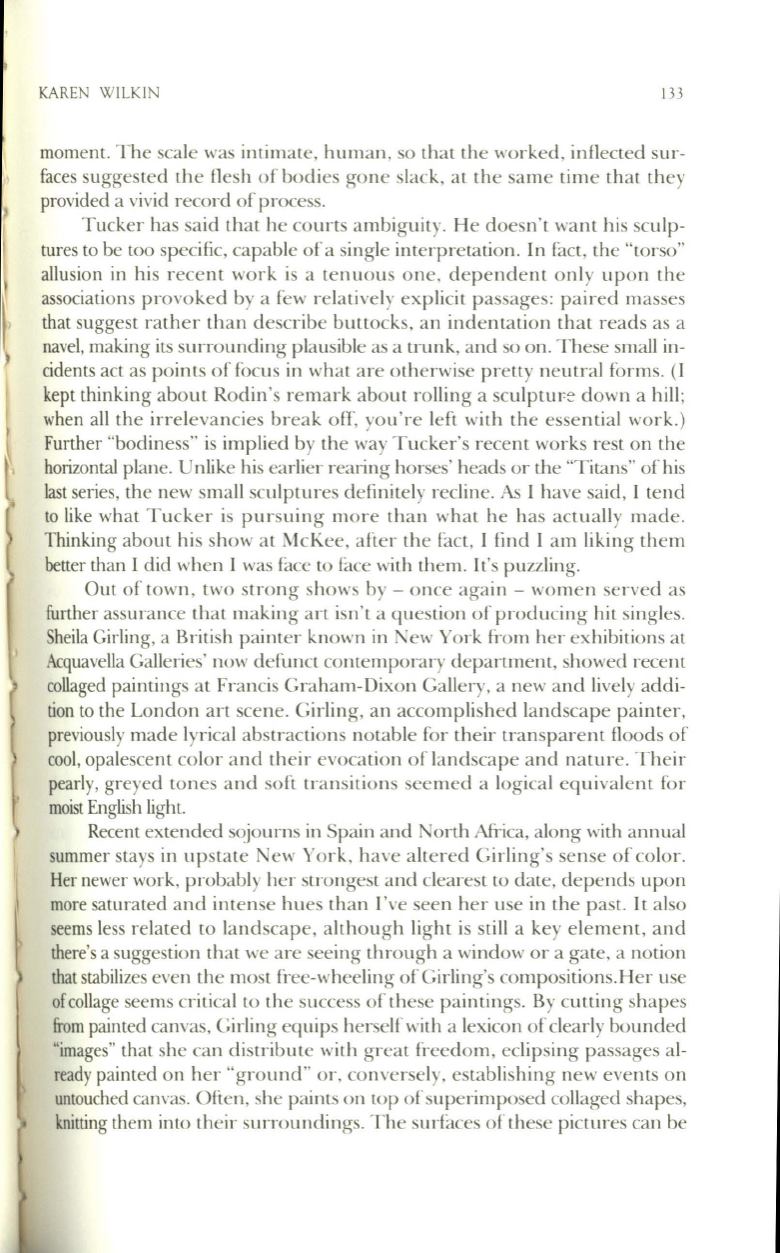
KAREN WILKIN
133
moment. The scale was intimate, human , so that the worked, inflected sur–
faces suggested the flesh of bodies gone slack, at the same time that they
provided a vivid record of process.
Tucker has said that he courts ambiguity. He doesn't want his sculp–
tures to be too specific, capable of a single interpretation. In fact, the "torso"
allusion in his recent work is a tenuous one, dependent only upon the
associations provoked by a few relatively explicit passages: paired masses
that suggest rather than describe buttocks, an indentation that reads as a
navel, making its surrounding plausible as a trunk, and so on. These small in–
cidents act as points of fDcus in what are otherwise pretty neutral forms. (I
kept thinking about Rodin's remark about rolling a sculpture down a hill;
when all the irrelevancies break
off,
you're left with the essential work.)
Further "bodiness" is implied by the way Tucker's recent works rest on the
horizontal plane. Unlike his earlier rearing horses' heads or the ''Titans'' of his
last series, the new small sculptures definitely recline.
As
I have said, I tend
to like what Tucker is pursuing more than what he has actually made .
Thinking about his show at McKee, after the fact, I find I am liking them
better than I did when I was face to
1~\Ce
with them. It's puzzling.
Out of town, two strong shows by - once again - women served as
further assurance that making art isn 't a question of producing hit singles.
Sheila Girling, a Br'itish painter known in New York Ii-om her exhibitions at
Acquavella Galleries' now defunct contemporary department, showed recent
collaged paintings at Francis Graham-Dixon Gallery, a new and lively addi–
tion to the London art scene. Girling, an accomplished landscape painter,
previously made lyrical abstractions notable for their transparent floods of
cool, opalescent color and their evocation of landscape and nature. Their
pearly, greyed tones and soft transitions seemed a logical equivalent for
moist English light.
Recent extended sojourns in Spain and North Africa, along with annual
ummer stays in upstate New York, have altered Girling's sense of color.
Her newer work, probably her strongest and clearest
to
date, depends upon
more saturated and intense hues than I've seen her use in the past.
It
also
seems less related to landscape, although light is still a key element, and
there's a suggestion that we are seeing through a window or a gate, a notion
that stabilizes even the most fi-ee-wheeling of Girling's compositions. Her use
of collage seems critical to the success of these paintings. By cutting shapes
from painted canvas, Girling equips herself with a lexicon of clearly bounded
"images" that she can distribute with great fi-eedom, eclipsing passages al–
ready painted on her "ground" or, conversely, establishing new events on
untouched canvas. Ofi.en, she paints on top of superimposed collaged shapes,
knitting them into their surroundings. The surfaces of these pictures can be


